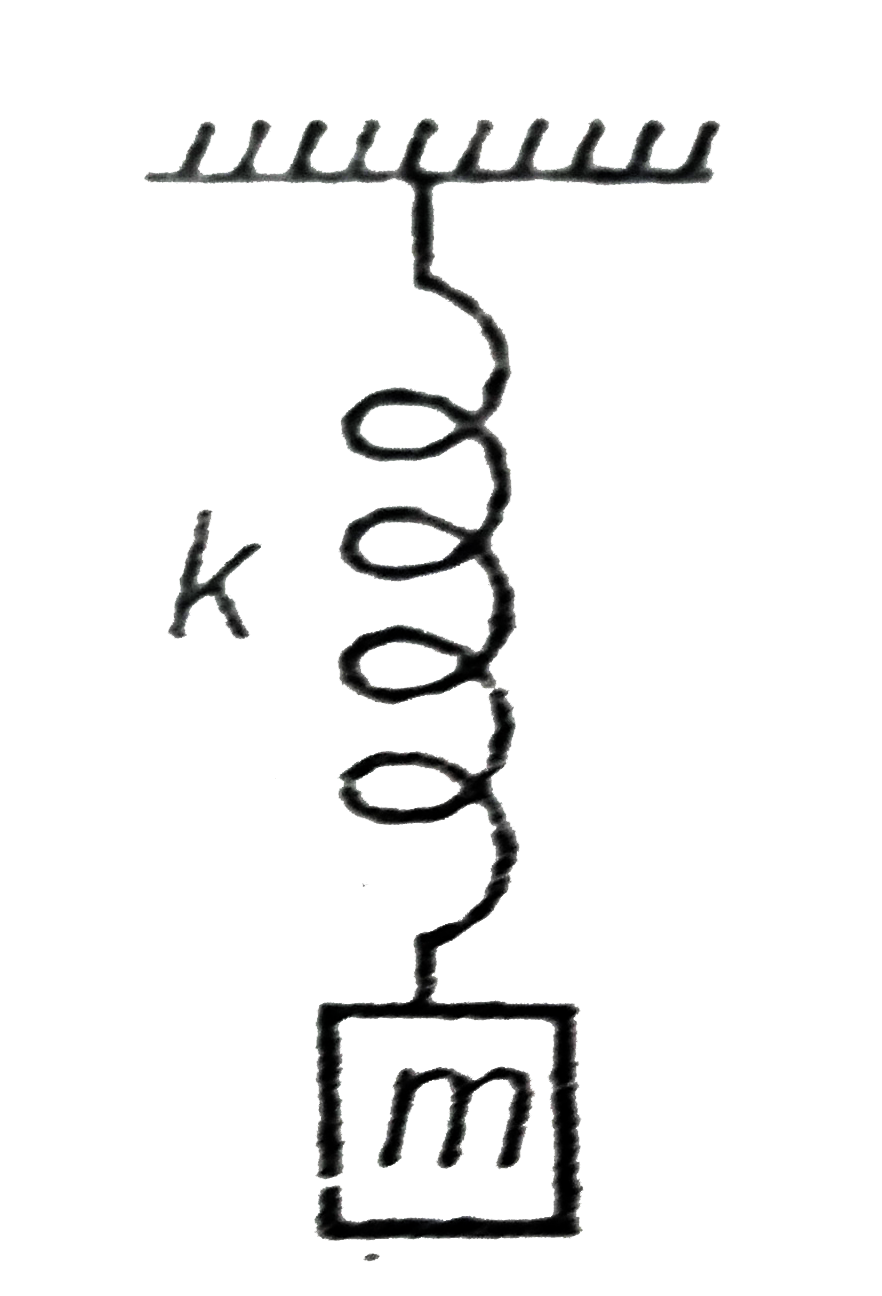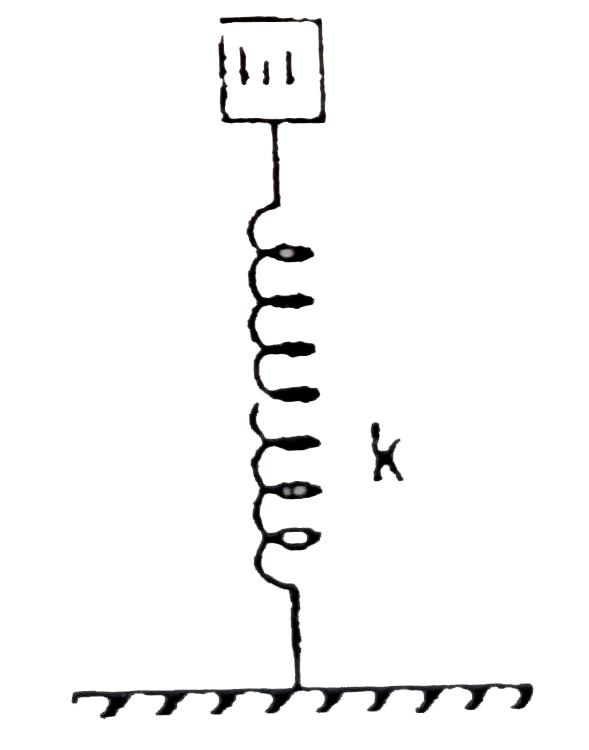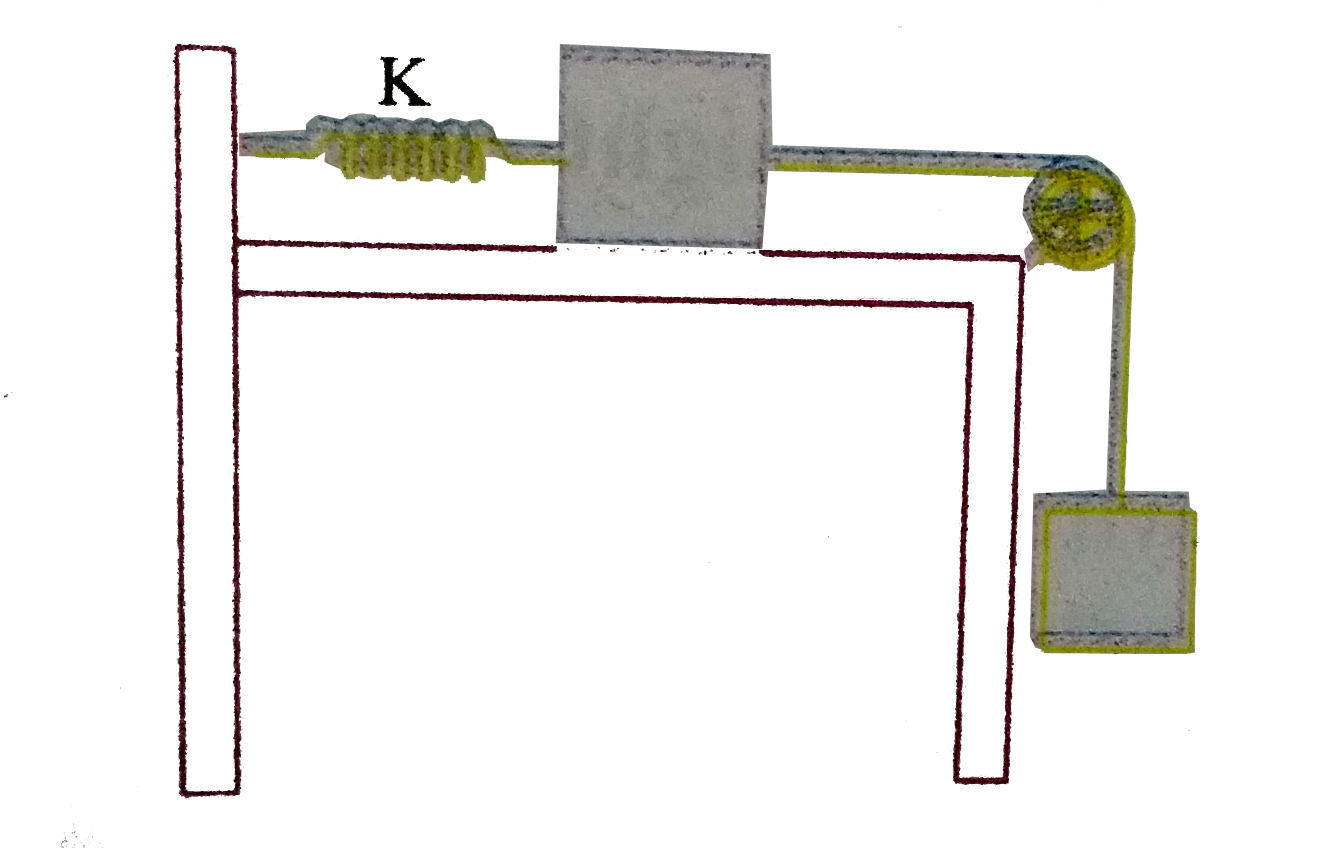A block of mass m, attacted to a string of spring constant k, oscillates on a smooth horizontal table. The other end of the spring is fixed to a wall. The block has a speed v when the spring is at its natural length. Before coming to an instantaneous rest. If the block moves a distance x from the mean position, then
x=√mk
a=1v√mk
x=v√mk
x=√mvk
The correct Answer is:C
To solve the problem step by step, we will analyze the energy transformations that occur as the block oscillates on the spring.
1. Understanding the System:
The block of mass m is attached to a spring with spring constant k. The spring is fixed at one end to a wall, and the block can move horizontally on a smooth table.
2. Initial Conditions:
When the spring is at its natural length (unstretched), the block has a speed v. At this point, all the energy of the system is kinetic energy since the potential energy stored in the spring is zero.
KE=12mv2
3. Maximum Stretching:
As the block moves away from the mean position (natural length of the spring), it stretches the spring by a distance x. At this maximum stretch, the block comes to an instantaneous rest, meaning its speed is 0. At this point, all the energy is converted into potential energy stored in the spring.
PE=12kx2
4. Conservation of Energy:
The total mechanical energy in the system remains constant. Therefore, the kinetic energy when the spring is at its natural length is equal to the potential energy at maximum stretch:
12mv2=12kx2
5. Simplifying the Equation:
We can eliminate the 12 from both sides of the equation:
mv2=kx2
6. Solving for x:
Rearranging the equation to solve for x:
x2=mv2k
Taking the square root of both sides gives:
x=v√mk
Final Answer:
Thus, the distance x from the mean position when the block comes to an instantaneous rest is:
x=v√mk
The block of mass m is attached to a spring with spring constant k. The spring is fixed at one end to a wall, and the block can move horizontally on a smooth table.
When the spring is at its natural length (unstretched), the block has a speed v. At this point, all the energy of the system is kinetic energy since the potential energy stored in the spring is zero.
As the block moves away from the mean position (natural length of the spring), it stretches the spring by a distance x. At this maximum stretch, the block comes to an instantaneous rest, meaning its speed is 0. At this point, all the energy is converted into potential energy stored in the spring.
The total mechanical energy in the system remains constant. Therefore, the kinetic energy when the spring is at its natural length is equal to the potential energy at maximum stretch:
We can eliminate the 12 from both sides of the equation:
Rearranging the equation to solve for x:
Thus, the distance x from the mean position when the block comes to an instantaneous rest is:
Similar Questions
A block of mass m, attached to a spring of spring constant k, oscilltes on a smooth horizontal table. The other end of the spring is fixed to a wall. If it has speed v when the spring is at its naturla lenth, how far will it move on the table before coming to an instantaneous rest?
View SolutionA block of mass 2kg is attached with a spring of spring constant 4000Nm−1 and the system is kept on smooth horizontal table. The other end of the spring is attached with a wall. Initially spring is stretched by 5cm from its natural position and the block is at rest. Now suddenly an impulse of 4kg−ms−1 is given to the block towards the wall.
Find the velocity of the block when spring acquires its natural length
View SolutionA block of mass 2kg is attached with a spring of spring constant 4000Nm−1 and the system is kept on smooth horizontal table. The other end of the spring is attached with a wall. Initially spring is stretched by 5cm from its natural position and the block is at rest. Now suddenly an impulse of 4kg−ms−1 is given to the block towards the wall.
Approximate distance travelled by the block when it comes to rest for a second time (not including the initial one) will be (Take √45=6.70)
View SolutionA block of mass 2kg is attached with a spring of spring constant 4000Nm−1 and the system is kept on smooth horizontal table. The other end of the spring is attached with a wall. Initially spring is stretched by 5cm from its natural position and the block is at rest. Now suddenly an impulse of 4kg−ms−1 is given to the block towards the wall.
Approximate distance travelled by the block when it comes to rest for a second time (not including the initial one) will be (Take √45=6.70)
View SolutionThe block of mass m is released when the spring was in its natrual length. Spring constant is k. Find the maximum elongation of the spring.

View SolutionA block of mass m is attached to a spring of force constant k whose other end is fixed to a horizontal surface. Initially the spring is in its natural length and the block is released from rest. The average force acting on the surface by the spring till the instant when the block has zero acceleration for the first time is

View SolutionA block of mass m is attached to one end of a mass less spring of spring constant k. the other end of spring is fixed to a wall the block can move on a horizontal rough surface. The coefficient of friction between the block and the surface is μ then the compession of the spring for which maximum extension of the spring becomes half of maximum compression is .
View SolutionA block of mass m is connect to another block of mass M by a massless spring of spring constant k. The blocks are kept on a smooth horizontal plane. Initially the blocks are at rest and the spring is upstretched when a constant force F starts acting on the block of mass M to pull it. Find the maximum extension of the spring.

View SolutionA block of mass m is connect to another block of mass M by a massless spring of spring constant k. The blocks are kept on a smooth horizontal plane. Initially the blocks are at rest and the spring is unsrtretched when a constnt force F starts acting on the block of mass M to pull it. Find the maximum extension of the spring.

View SolutionTwo blocks, of masses M and 2M, are connected to a light spring of spring constant K that has one end fixed, as shown in figure. The horizontal surface and the pulley are frictionless. The blocks are released from when the spring is non deformed. The string is light.
 .
.
View Solution
